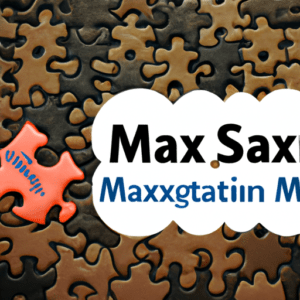Using Growth Hacking to Optimize SaaS Growth

In the fast-paced world of SaaS (Software as a Service), growth is paramount. It’s not enough to simply launch a product and hope for the best—success lies in optimizing growth through strategic tactics. In this article, we will explore the concept of growth hacking and how it can be used to maximize the growth potential of SaaS businesses. From leveraging data analytics to implementing targeted marketing campaigns, growth hacking offers a unique approach to driving expansion and capturing market share. Join us as we delve into the world of growth hacking and discover the key strategies that can propel your SaaS business to new heights.
Using Growth Hacking to Optimize SaaS Growth

Introduction
SaaS (Software as a Service) businesses have revolutionized the way companies operate and provide services to their customers. With the increasing popularity of SaaS, the competition in this industry has become intense. In order to sustain and thrive in this competitive landscape, SaaS companies need to have a growth mindset and continuously optimize their growth strategies. This is where growth hacking comes into play.
Understanding Growth Hacking
Growth hacking is a term that was coined by Sean Ellis, the founder and CEO of GrowthHackers, to describe the process of rapid experimentation across marketing channels to identify the most effective ways to grow a business. Unlike traditional marketing, growth hacking focuses on leveraging data and analytics to drive scalable and sustainable growth.

Key Metrics for SaaS Growth
To effectively optimize SaaS growth, it is important to track and analyze key metrics that indicate the health and performance of the business. Some key metrics for SaaS growth include:
Customer Acquisition Cost (CAC)
CAC refers to the cost associated with acquiring a new customer. By calculating CAC, SaaS companies can evaluate the efficiency and effectiveness of their marketing and sales efforts.
Customer Lifetime Value (CLTV)
CLTV measures the total revenue that a customer is expected to generate throughout their relationship with the company. Understanding CLTV allows SaaS businesses to focus on acquiring high-value customers and optimizing customer retention strategies.
Churn Rate
Churn rate measures the rate at which customers cancel or stop using a SaaS product or service. By monitoring churn rate, SaaS companies can identify areas of improvement in their product or customer experience to reduce customer attrition.
Retention Rate
Retention rate measures the proportion of customers that continue to use a SaaS product or service over a specific period of time. Improving retention rate is crucial for sustainable growth and increasing customer lifetime value.
Monthly Recurring Revenue (MRR)
MRR is the predictable revenue that a SaaS company can expect on a monthly basis. By tracking MRR, SaaS businesses can monitor their revenue growth and make data-driven decisions to optimize pricing strategies and increase customer value.
Identifying User Segments
To effectively optimize SaaS growth, it is important to understand and segment the target audience. By segmenting users based on demographics, behavior, and psychographics, SaaS companies can tailor their marketing and product strategies to specific user segments.
Importance of User Segmentation
User segmentation allows SaaS companies to understand the needs, preferences, and behaviors of different customer segments. This enables personalized marketing and product experiences, leading to increased customer satisfaction and retention.
Demographic Segmentation
Demographic segmentation involves categorizing users based on demographic characteristics such as age, gender, location, and industry. This segmentation helps SaaS companies target specific user groups with relevant marketing messages and product offerings.
Behavioral Segmentation
Behavioral segmentation involves categorizing users based on their actions, behaviors, and engagement with a SaaS product or service. This segmentation helps SaaS companies identify power users, inactive users, and potential churn risks, allowing them to target each group with appropriate strategies.
Psychographic Segmentation
Psychographic segmentation involves categorizing users based on their attitudes, interests, and values. This segmentation helps SaaS companies understand the motivations and preferences of different user segments, enabling them to create personalized marketing campaigns and product features.
Identifying High-Value User Segments
Identifying high-value user segments is crucial for optimizing SaaS growth. By analyzing user behavior, engagement, and conversion data, SaaS companies can identify segments that have a high potential for revenue growth and customer advocacy. These high-value segments can then be targeted with personalized marketing and engagement strategies.

Creating a Conversion Funnel
A conversion funnel is a visual representation of the user journey from initial awareness to becoming a paying customer. By creating a conversion funnel, SaaS companies can identify and optimize key stages of the user journey.
Understanding the Conversion Funnel
The conversion funnel consists of multiple stages, including awareness, interest, consideration, conversion, and post-conversion. Each stage represents a step in the user journey and requires different marketing and engagement strategies to move users closer to becoming paying customers.
Awareness Stage
The awareness stage is the first stage of the conversion funnel, where users become aware of a SaaS product or service. At this stage, it is important to create brand awareness and generate interest through targeted marketing campaigns, content marketing, and social media marketing.
Interest Stage
The interest stage is where users show active interest in a SaaS product or service. At this stage, it is crucial to provide users with valuable information, product demos, and free trials to further engage and educate them about the benefits and features of the product.
Consideration Stage
The consideration stage is where users evaluate and compare different SaaS products or services. At this stage, it is important to provide users with social proof, customer testimonials, and case studies to build trust and credibility.
Conversion Stage
The conversion stage is where users make the decision to become paying customers. At this stage, it is important to provide a seamless and user-friendly sign-up and onboarding process, as well as clear pricing and package options.
Post-Conversion Stage
The post-conversion stage is where users become active customers and start using the SaaS product or service. At this stage, it is important to provide ongoing customer support, personalized onboarding, and regular engagement to ensure customer satisfaction and retention.
A/B Testing for Continuous Optimization
A/B testing is a method of comparing two versions of a webpage or marketing campaign to determine which one performs better. By implementing A/B testing, SaaS companies can continuously optimize their marketing strategies and improve conversion rates.
What is A/B Testing?
A/B testing involves creating two versions (A and B) of a webpage or marketing campaign and randomly splitting the users into two groups, each group seeing one version. By measuring the performance of each version, SaaS companies can determine which version performs better in terms of conversions, click-through rates, or other desired metrics.
Setting Up A/B Tests
To set up A/B tests, SaaS companies need to identify specific elements or variables to test, such as headlines, call-to-action buttons, pricing options, or email subject lines. They should then create two versions with only one variable changed between them.
Analyzing A/B Test Results
Once the A/B tests are conducted, SaaS companies need to analyze the results and determine which version performed better in terms of the desired metrics. By analyzing the data, SaaS companies can make data-driven decisions and adjustments to optimize their marketing strategies.
Iterating and Scaling
A/B testing should be an ongoing process for SaaS companies. By continuously testing and iterating on different elements and variables, SaaS companies can optimize their marketing strategies and improve conversion rates. Successful tests can also be scaled up to drive significant growth and impact.
Leveraging Social Media for Growth
Social media has become an integral part of our daily lives, and it presents a great opportunity for SaaS companies to reach and engage with their target audience. By leveraging social media, SaaS companies can drive growth and increase brand awareness.
Choosing the Right Social Media Platforms
Not all social media platforms are suitable for every SaaS business. It is important for SaaS companies to identify the platforms that their target audience is most active on and focus their efforts on those platforms. Popular social media platforms for SaaS businesses include LinkedIn, Twitter, and Facebook.
Creating Engaging Content
Social media is driven by content, and creating engaging content is key to capturing the attention and interest of the target audience. SaaS companies should focus on creating valuable and relevant content that provides insights, solves problems, and educates the audience about their products or services.
Building a Social Media Following
Building a social media following takes time and effort. SaaS companies should actively engage with their audience by responding to comments, initiating conversations, and sharing valuable content on a consistent basis. They should also utilize hashtags, influencers, and user-generated content to increase visibility and reach.
Measuring Social Media Success
Measuring the success of social media efforts is crucial to optimize strategies and track the return on investment (ROI). SaaS companies should track metrics such as engagement rate, reach, click-through rate, and conversion rate to evaluate the effectiveness of their social media campaigns.
Implementing Referral Programs
Referral programs are a powerful way to leverage the existing customer base and drive organic growth. By implementing referral programs, SaaS companies can encourage their customers to refer new customers, leading to increased customer acquisition and retention.
Benefits of Referral Programs
Referral programs offer several benefits for SaaS companies. They can generate high-quality leads, increase customer loyalty and advocacy, and reduce customer acquisition costs. Referral programs also create a sense of community and trust among customers.
Designing an Effective Referral Program
To design an effective referral program, SaaS companies should clearly define the incentives for both the referrer and the referee. The incentives should be attractive enough to encourage customers to participate and refer others. SaaS companies should also provide easy-to-use referral mechanisms and track the referral activity.
Promoting Referral Programs
Promoting referral programs is essential to maximize participation. SaaS companies should actively communicate and promote the referral program through various marketing channels such as email campaigns, social media posts, website banners, and in-app notifications. They should also incentivize the initial sign-up and reward customers for successful referrals.
Tracking and Rewarding Referrals
Tracking and rewarding referrals is crucial to keep the referral program transparent and fair. SaaS companies should implement a tracking system to accurately record and attribute referrals. They should also provide timely and meaningful rewards to referrers and referees, such as discounts, free upgrades, or exclusive access to new features.
Optimizing Onboarding and User Experience
An effective onboarding process and a positive user experience are key to retaining customers and driving long-term growth. By optimizing onboarding and user experience, SaaS companies can enhance customer satisfaction, reduce churn, and increase customer lifetime value.
Designing a Seamless Onboarding Process
The onboarding process is the first interaction a customer has with a SaaS product or service, and it sets the tone for the overall user experience. SaaS companies should design a seamless and intuitive onboarding process that guides customers through the product features, helps them set up their accounts, and provides initial value.
Personalizing the User Experience
Personalization is crucial for creating a positive user experience. SaaS companies should utilize customer data and insights to personalize the user experience by displaying relevant content, recommending relevant features, and providing targeted support. Personalization can enhance customer satisfaction and increase engagement.
Providing Ongoing Customer Support
Customers may have questions or encounter issues throughout their journey with a SaaS product or service. It is important for SaaS companies to provide ongoing customer support through various channels such as email, live chat, or self-service portals. Prompt and helpful customer support can increase customer satisfaction and loyalty.
Collecting and Analyzing User Feedback
User feedback is a valuable source of insights for improving the product and user experience. SaaS companies should actively collect and analyze user feedback through surveys, feedback forms, and customer interviews. By addressing user feedback and iteratively improving the product, SaaS companies can enhance customer satisfaction and retention.
Retention Strategies for SaaS Growth
Retention is a critical factor for sustainable SaaS growth. By implementing effective retention strategies, SaaS companies can reduce churn, increase customer lifetime value, and drive long-term growth.
Analyzing Churn Patterns
Understanding churn patterns is crucial for developing effective retention strategies. SaaS companies should analyze churn data to identify common churn reasons, customer segments at risk of churn, and opportunities for improvement in the product or customer experience. By addressing the root causes of churn, SaaS companies can proactively reduce churn.
Offering Frequent Product Updates and Enhancements
Continuously improving the product and adding new features is important for retaining customers. SaaS companies should regularly release product updates and enhancements based on user feedback and market trends. By providing value through ongoing improvements, SaaS companies can increase customer satisfaction and loyalty.
Implementing Customer Success Programs
Customer success programs are designed to help customers achieve their desired outcomes and maximize the value they receive from a SaaS product or service. SaaS companies should implement customer success programs that include onboarding support, ongoing training, proactive engagement, and performance tracking. By ensuring that customers are successful with the product, SaaS companies can increase retention rates.
Offering Flexible Pricing and Packaging Options
Pricing and packaging options can have a significant impact on customer retention. SaaS companies should offer flexible pricing plans and packages that cater to different customer needs and budgets. By providing options that align with customer preferences, SaaS companies can reduce price-related churn and increase customer satisfaction.
Proactively Engaging with Customers
Proactive engagement is key to building strong relationships with customers. SaaS companies should regularly engage with customers through various channels such as email newsletters, in-app notifications, and personalized messages. By providing relevant content, product updates, and support, SaaS companies can increase customer engagement and loyalty.
Conclusion
Growth hacking is a crucial strategy for optimizing SaaS growth. By understanding the key principles of growth hacking, tracking key metrics, identifying user segments, creating a conversion funnel, implementing A/B testing, leveraging social media, implementing referral programs, optimizing onboarding and user experience, and implementing retention strategies, SaaS companies can drive sustainable and scalable growth. With the continuous evolution of the SaaS industry, growth hacking will continue to play a crucial role in the future of SaaS growth.







